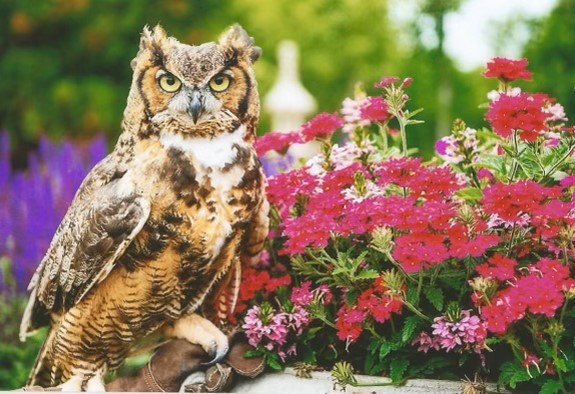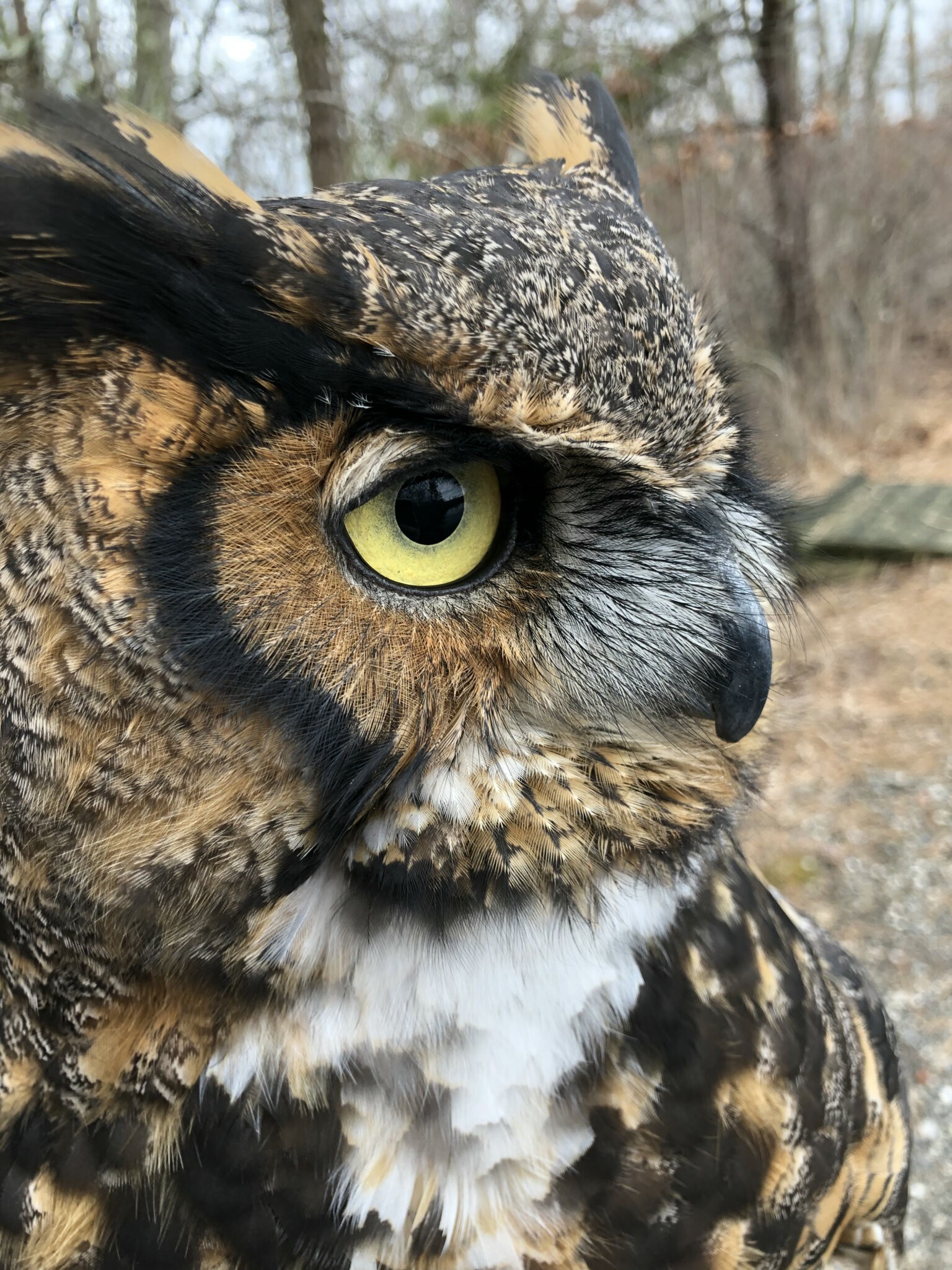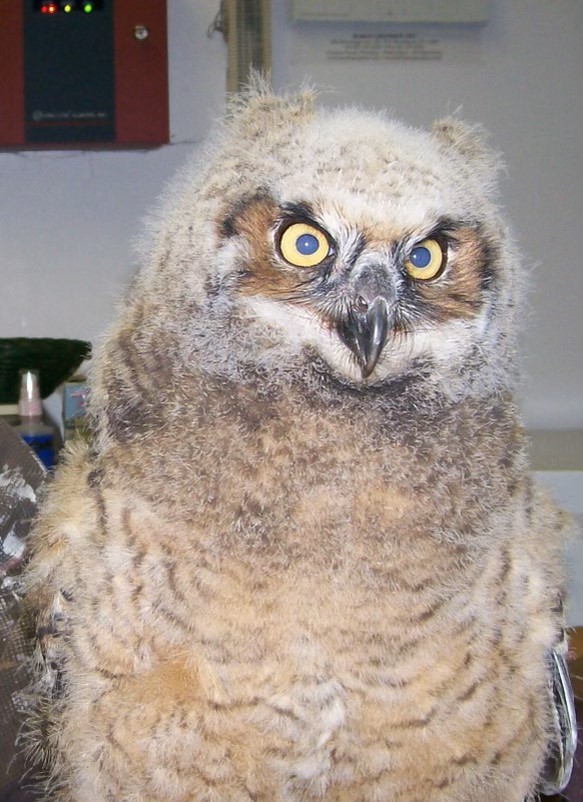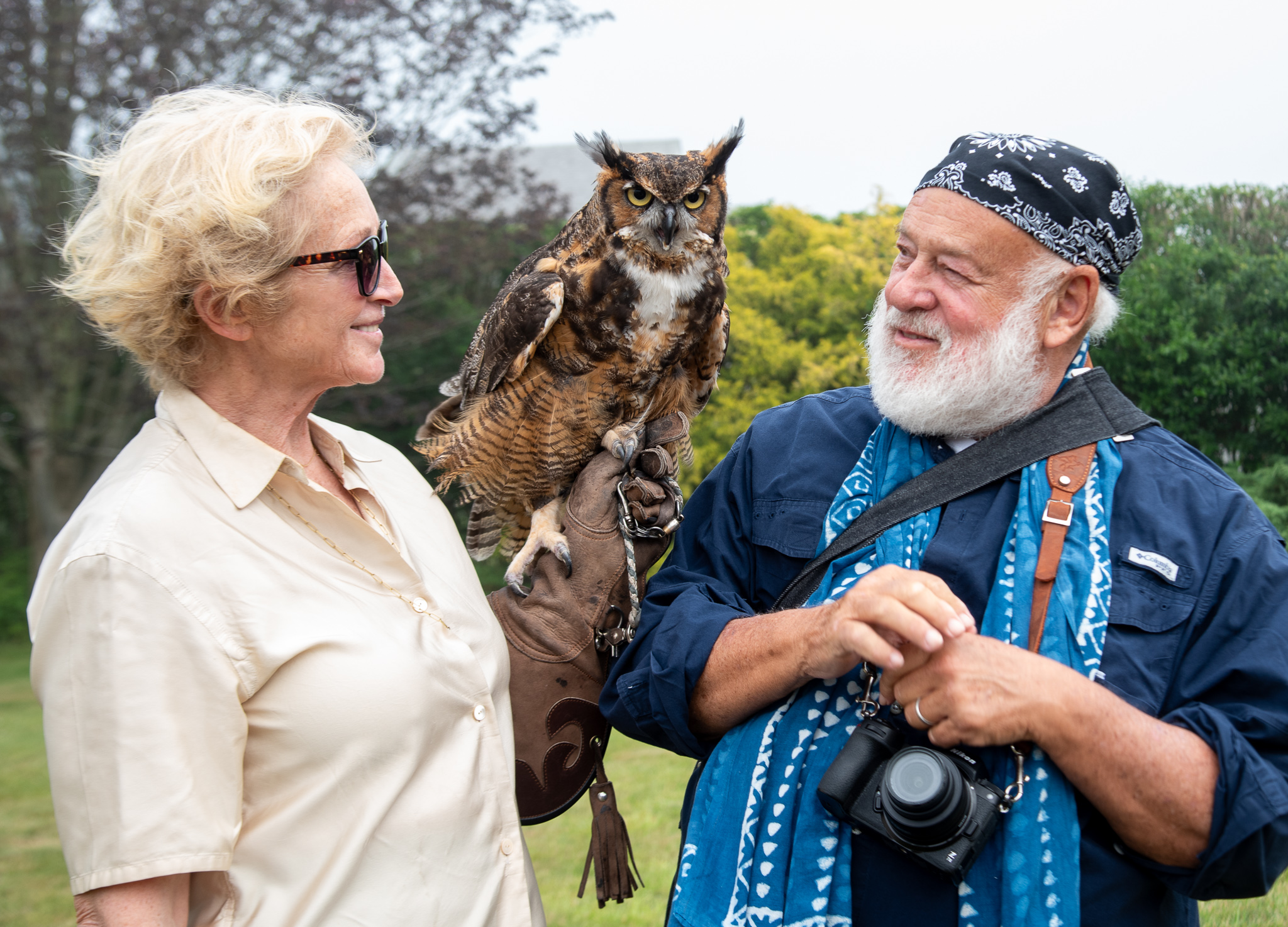Evelyn Alexander Wildlife: Meep the Great Horned Owl Celebrates 17th Birthday

Brought to the Evelyn Alexander Wildlife Rescue Center in Hampton Bays at just a couple weeks old in late February 2007, Meep has long been a dedicated educational program owl for the wildlife rescue center after her rehabilitation was completed.
Found after falling out of her 65-foot-high nest, Meep, a female great horned owl, was in critical condition with a majority of her bones broken, especially in her pelvis and wing. She was even considered for euthanasia due to the severity of the damage. However, despite being so young and frightened, Meep was responding extremely well to medication and was eating, which is uncommon for injured or stressed animals.
Thanks to the intensive care, and despite the wildlife rescue center’s efforts to prevent habituation toward people, Meep imprinted on humans. After imprinting on the employees of the center, her rehabilitation was considered, and she continued to heal, grow and fly into the healthy adult owl she is today.
There are unfortunately numerous stories similar to Meep’s — of baby great horned owls falling out of their nests. This is usually a ramification of their natural mating patterns.
Great horned owls are the first birds to mate each season, starting as early as December and continuing throughout winter. The season’s high speed windstorms and snowstorms are often responsible for the damage and weakening of many owls’ nests. This results in situations where baby owls can fall with, or out of, their nests. Once a baby falls out of their nest, the parents can do their best to protect their young on the ground, but in most cases, nature will eventually take its course. Meep was lucky to have been found and rehabilitated, as many baby great horned owls suffer a grim fate once landing on the forest floor.

While Meep could have been released, her imprinting causes her to associate heavily with humans,restricting her ability to learn to hunt. Considering this great disadvantage in the wild, Meep became a permanent ambassador of the Evelyn Alexander Wildlife Rescue Center. Her imprint is also why she is one of the center’s best educational program animals, as she is unafraid of humans and has developed a strong personality.
Meep is a personable creature that loves to observe: She watches the other birds at the center, the outdoor cats that roam the premises, the wildlife rescue center employees walking by. Despite knowing she’s an owl, Meep seems to view herself near humans due to her imprint. This also makes her quite dangerous, as she will thoroughly express her emotions to employees (whether it be love or anger.)
Thoroughly making her preferences known, Meep has a lively personality that she showcases to all she encounters. While most great horned owls eat a variety of small animals, Meep is partial to mice, although she tolerates rats and despises eating chicks. Among Meep’s favorite activities is embarking on snowy forest walks during the winter, making the most of her favorite season.
Great horned owls are covered in extremely soft feathers that insulate them against the cold winter weather and help them fly quietly in pursuit of prey. Their short, wide wings allow them to effortlessly maneuver among the dense trees, which is likely why Meep prefers a wintry forest setting.
As an apex predator of the skies, great horned owls are fierce hunters that can take large prey, including raptors such as ospreys, peregrine falcons, prairie falcons and other owls. While owls cannot move their eyes, their famous head spin can rotate up to 270 degrees, making it easier to spot prey.
Great horned owls have even shown to match up against eagles in the wild, whether in defense of their nests, or even dive bombing sleeping eagles. Despite the generous size difference, great horned owls are the only bird species that come close to matching an eagle’s talon strength, and when clenched, a great horned owl’s strong talons require a force of 28 pounds to open. The owl uses this deadly grip to sever the spine of large prey.
For Meep, her glory extends to the wildlife rescue center, where she holds the title of largest owl at the center.

Having no natural predators, adult great horned owls are typically victims only of rat poison, car accidents or other unnatural circumstances. This is why the wildlife rescue center advises the public to never put out rat or mice poison, as these products pose serious risks to unintended targets including the great horned owl.
Despite female great horned owls being much larger than their male counterparts, Meep is on the smaller side for her species. Other than the difference in size, males typically have a larger voice box and a deeper-pitched call. Pairs often call together, with audible differences in pitch.
Great horned owls will mate for life, but will sometimes pair with another mate in the event their first mate dies. Some owls have been found to have two mates and “cheat” on each other, although the situation is rare. In courtship, males usually perform a display flight and feed the female they are courting.
Like many other birds in a mating pair, female great horned owls will take care of their young while the male will circle around, searching for any potential incoming dangers. American crows, one of the top nuisances for great horned owls, can often be seen mobbing and annoying the magnificent breed. Crows will gather from near and far to harass the owl in packs for hours, hoping to eventually raid the nest. In this case, the male will often fly away and draw the crows far from the nest, using any method possible to distract them. A male great horned owl has even been seen “dancing” as a creative maneuver to keep the crows distracted.
Since most great horned owls don’t mate in captivity, Meep is a solitary bird, and her aggressive nature renders her unable to live with other female great horned owls.
While Meep was severely injured when she fell out of her nest, many fallen baby owls remain relatively intact, their only disadvantage being stranded on the forest floor. Luckily, there are ways to save a baby owl that has fallen from its nest.

While many well-intentioned people will put the baby back into a tree, there is little a young owl can do without a nest. By nature, owls don’t make nests themselves, instead repurposing old nests. In fact, owls barely add to the nests they take over, at most sprucing up with a couple twigs and feathers. Because of this, just about anything that resembles a nest and is in a desirable location, typically around 20–60 feet above the ground, can be habited by an owl.
The wildlife rescue center has successfully taught people to attach tote storage containers up high to trees, close to where a baby owl was found, via screws and bolts. By placing the baby owl inside, the parent owls will often accept this as a new nest and use the makeshift home to raise the baby. Additionally, like humans, pairs of great horned owls have been proven to adopt orphaned young owls in the right setting.
By using these unconventional nests, this method can save baby owls from unfortunate circumstances or can be used to facilitate an adoption. Climbing onto nearby branches at 5 weeks old, these babies can learn to fly at about 9–10 weeks old, and will be tended to and fed by parents for up to several months as a family.
Great horned owls can live to a whopping 20–30 years in captivity; the world record being 50 years. At 17, Meep is living her best life as an educational program bird, and spreading her energetic and unique personality to the local community.
The Evelyn Alexander Wildlife Rescue Center, a 501(c)(3) not-for-profit organization, depends on donations from the local community, businesses and visitors, to continue rescuing and rehabilitating Long Island’s wildlife year-round. Dedicated to reducing the threatening impact of humans on wildlife, the refuge can only function with your help.
The center is located at 228 West Montauk Highway, Hampton Bays. It can be reached at 631-728-4200, and animal emergencies can be reported at 631-728-WILD (9453). The center is open 9 a.m.–5 p.m. seven days weekly. Visit wildliferescuecenter.org for info.



